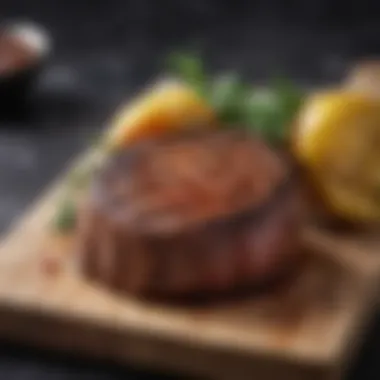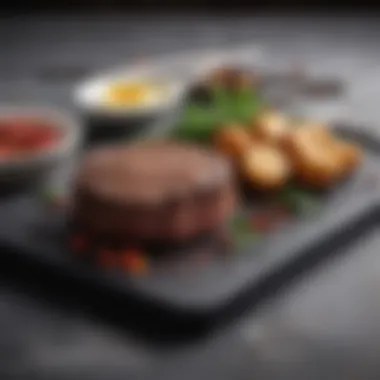Mastering the Art of Cooking Filet Mignon


Intro
Filet mignon is often viewed as the pinnacle of beef cuts. Its reputation is built on its tenderness and rich flavor, making it a favorite among food enthusiasts. However, mastering the art of cooking filet mignon goes beyond simply following a recipe. It involves understanding the intricacies of preparation and techniques that affect the overall result. This guide aims to dissect the various approaches to cooking filet mignon, focusing on the best practices that lead to perfectly cooked meat.
Drawing on expert insights, we will explore how factors like cooking duration and desired doneness can transform this noble cut into a culinary masterpiece. We will also address common misconceptions that might lead to less than satisfactory outcomes. With the right knowledge, both novice and seasoned cooks can achieve impressive results. The following sections will lay out detailed methods for grilling, pan-searing, and oven-roasting filet mignon. Furthermore, we will provide serving suggestions to elevate your dining experience. The goal is to equip you with a thorough understanding of filet mignon, ensuring you can enjoy this exceptional dish at its finest.
Understanding Filet Mignon
Understanding filet mignon is crucial for properly preparing this prized cut of beef. Recognizing its attributes, from the marbling to the texture, sets the foundation for cooking it perfectly. This section delves into its definition, characteristics, and historical context to enhance appreciation as well as cooking skill.
What is Filet Mignon?
Filet mignon refers to a specific part of the beef tenderloin. It is one of the most sought after cuts due to its tenderness and mild flavor. The name comes from the French terms meaning "dainty fillet." This cut is typically small, which adds to its premium status, and often commands a higher price point in restaurants and butcher shops. Knowing what filet mignon is will guide cooks in selecting the right piece when shopping.
The Cut of Meat: Characteristics
Filet mignon is recognized for its fine grain and lack of fat, making it a favorite among those who prefer lean cuts. Its delicate flavor allows for versatility in preparation. Cooks should be aware of the following characteristics:
- Texture: Soft and buttery, it is easy to cut and chew.
- Marbling: Limited marbling leads to less flavor compared to fattier cuts like ribeye.
- Size: Typically, each steak weighs between six to eight ounces, contributing to its appeal as a high-end dining option.
- Color: A bright red hue indicates freshness, while darker shades might denote age.
Understanding these elements can enhance the cooking process and ultimately improve the dining experience.
Origin and Popularity
The popularity of filet mignon can be traced back to its origins in France, where culinary traditions emphasized high-quality ingredients. As French cuisine transformed American dining, filet mignon found its place as a luxurious choice. Today, this cut is not just celebrated in fine dining. Many home cooks aspire to recreate restaurant-quality meals. The growing interest in grilling and gourmet cooking has cemented filet mignon as a staple in many kitchens.
Skills in preparing this cut allow cooks to elevate their culinary repertoire. Understanding its roots and desirability provides context for its esteemed status in kitchens worldwide.
"Filet mignon remains a symbol of culinary excellence, prized for its tenderness and celebrated across culinary traditions."
As we continue this guide, these foundational aspects will assist readers in mastering filet mignon cooking techniques, resulting in unforgettable meals.
Factors Influencing Cooking Time
Cooking filet mignon to perfection requires an understanding of various factors that influence its cooking time. Getting these elements right is essential for achieving the desired doneness as well as texture. Each variable can greatly impact the final outcome of your steak, leading to a satisfying meal or a disappointment. Understanding these influences helps ensure you serve a filet mignon that is tender, juicy, and full of flavor.
Thickness of the Steak
The thickness of the steak plays a crucial role in determining how long it should be cooked. A thicker filet mignon will naturally require a longer cooking time compared to a thinner cut. Typically, a standard filet mignon comes in thicknesses ranging from one to two inches. This thickness affects how heat penetrates the meat, with thicker cuts taking longer to reach the desired internal temperature. Therefore, understanding your steak's thickness allows you to time your cooking accurately.
Desired Doneness
The level of doneness is another essential factor that dictates cooking time. Different temperatures correlate with varying degrees of doneness, so it is important to choose the appropriate finish for your steak. Each doneness has its own set of time guidelines, impacting the texture and juiciness of the meat. Below are main degrees of doneness:
Rare
Rare is characterized by a cool, red center with an internal temperature of approximately 125°F (52°C). This choice is popular among purists as it retains the most moisture and flavor. Its unique feature is the soft, velvety texture. However, a rare filet mignon may not suit every palate, as some find it too undercooked.
Medium Rare
Medium rare is often considered the gold standard for many steak enthusiasts, featuring a warm red center at about 135°F (57°C). This doneness results in enhanced flavors while providing a satisfactory texture. The unique characteristic of medium rare is its ability to meld both juiciness and tenderness, which makes it a highly favored choice for filet mignon.
Medium


Medium carries a more pronounced pink center with an internal temperature of around 145°F (63°C). This doneness strikes a balance for those who want a steak that is neither too rare nor too well done. While it offers a decent amount of juiciness, it begins to lose some tenderness compared to medium rare.
Medium Well
At approximately 150°F (66°C), medium well is almost cooked through, featuring only a hint of pink in the center. This option is desirable for those who prefer a firmer texture. While some appreciate the slight chewiness, it can tend to be drier, which may not be ideal for filet mignon enthusiasts.
Well Done
Well done reaches an internal temperature of 160°F (71°C) or higher. While some diners prefer a fully cooked steak, it comes at the cost of tenderness and moisture. This doneness lacks the juicy attributes that filet mignon is known for, making it less popular among true steak lovers.
Cooking Method Employed
Various cooking methods can also impact cooking time significantly. Techniques like grilling, pan-searing, or oven-roasting each have unique ways of applying heat. Choosing the right method for cooking your filet mignon can hasten or prolong the cooking process, impacting the final result.
Resting Time After Cooking
Resting time after cooking is often overlooked but is integral to a successful steak presentation. Allowing the filet mignon to rest lets the juices redistribute. Without this, much of the desired moisture can escape when the steak is cut, leading to a less enjoyable eating experience. In general, a resting period of 5 to 10 minutes is recommended.
By being aware of these factors, one can confidently cook filet mignon to match personal or guest preferences.
Preparation Techniques
Preparation techniques are critical in mastering the cooking of filet mignon. Understanding these methods not only enhances flavor but also affects the texture and overall quality of the steak. From selecting the right ingredients to applying appropriate cooking methods, every detail plays an essential role in achieving a perfectly cooked filet mignon. By implementing effective preparation, you can significantly improve your culinary results and elevate your dining experience.
Choosing Quality Ingredients
Selecting quality ingredients is the cornerstone of any successful dish, particularly when it comes to filet mignon. The steak should be sourced from reputable suppliers, ideally grass-fed and free of hormones or antibiotics. Look for cuts with a deep red color and abundant marbling; this indicates tenderness and flavor.
When buying, consider:
- The thickness and poundage of the steak.
- The grade of the meat, such as USDA Prime or Choice.
- Freshness, if possible, examine the packaging date.
Investing in high-quality meat pays off, as it directly impacts the taste and texture.
Marinating and Seasoning
Marinating and seasoning is another vital technique for preparing filet mignon. Although filet mignon is inherently flavorful, a well-chosen marinade can further enhance its taste. Use simple marinades based on oil and acid, such as olive oil and balsamic vinegar, combined with herbs and spices. A 4 to 6 hour soak is generally sufficient.
When it comes to seasoning, kosher salt and freshly cracked black pepper are essential. They bring out the natural flavors of the meat. Apply seasoning generously just before cooking to achieve a crust that complements the steak's richness.
Searing Techniques
Searing techniques play an essential role in sealing in the juices of filet mignon. The goal of searing is to create a caramelized crust that deepens flavor and enhances presentation. Start with a hot skillet or grill. Place the steak in the pan or on the grill and leave it undisturbed for several minutes to develop a good crust. Flip and repeat for both sides. This method locks in moisture and produces a more flavorful result.
Optimal Cooking Equipment
Optimal cooking equipment can significantly affect the outcome of your filet mignon. Different methods have their own merits and limitations.
Grilling
Grilling is a popular method for cooking filet mignon. The direct heat provides a charred exterior while allowing for a juicy interior. The unique feature of grilling is the smoky flavor it infuses into the meat, enhancing its natural taste. However, it requires careful attention to prevent flare-ups and overcooking.
Pan-Searing
Pan-searing is another effective technique. This method uses a hot skillet to achieve a golden crust while retaining moisture. A key characteristic of pan-searing is its ease of use, making it suitable for beginner cooks. This technique allows for better control of cooking temperatures, but it can require some additional fat to prevent sticking.


Oven-Roasting
Oven-roasting offers an even cooking environment that gently cooks the meat. The benefit of this method is that it frees up the stovetop for other preparations. It allows for consistent results without requiring constant attention. The drawback is that it might take longer than other methods, which can be less desirable for those seeking a quicker meal.
Experimenting with different preparation techniques allows for personalization and creativity in the kitchen, making every cooking experience unique.
Cooking Methods and Time Guidelines
Understanding the various cooking methods and their corresponding time guidelines is essential for mastering filet mignon. Each method brings distinct flavors and textures to the meat. Knowing the right technique and timing not only enhances the culinary experience but also ensures that the filet mignon is cooked to perfection.
When it comes to filet mignon, the delicacy of the meat requires precise handling. Cooking time can vary significantly based on the chosen method, making it critical to have guidelines at hand. Factors like the thickness of the steak and the desired doneness are interlinked with the cooking method. Choosing an incorrect method or failing to adhere to time guidelines can result in an unappetizing dish.
Being well-versed in these methods enables cooks to make informed decisions, thus improving their skills in the kitchen.
Grilling Filet Mignon
Grilling filet mignon is a popular method that delivers a rich flavor thanks to the charred exterior it creates. Start by preheating the grill to a high temperature, around 450°F to 500°F. This ensures a good sear which locks in the juices.
- Preparation: Season the steak simply, perhaps with salt and pepper. If desired, a little olive oil can help with sticking.
- Cooking Time: Grill for about 4-5 minutes for rare, and up to 10-12 minutes for well-done.
- Tip: Use a digital meat thermometer to monitor internal temperatures. For medium-rare, aim for about 130°F internal temperature.
Pan-Searing Filet Mignon
Pan-searing is favored for its ability to create a caramelized crust using stovetop heat. In this method, a cast-iron skillet is ideal because it retains heat well.
- Preparation: Allow the filet to come to room temperature before cooking. This helps it cook more evenly. Season generously.
- Cooking Time: Sear for approximately 3-4 minutes on each side. Follow this with a brief stint in the oven at 400°F to achieve the desired doneness.
- Tip: Baste with butter and herbs during the last minutes to enhance flavor.
Oven-Roasting Filet Mignon
Oven-roasting is gentle and provides even cooking. It shines especially for thicker cuts of filet mignon.
- Preparation: Season the meat and sear it briefly on the stovetop first to develop a crust.
- Cooking Time: Roast at 425°F for 8-10 minutes. For accuracy, check with a thermometer, as the cooking time varies by thickness.
- Tip: Use a roasting pan that allows heat circulation around the steak for the best results.
Cooking Time Charts
Implementing cooking time charts serves as a quick reference for those unfamiliar with cooking filet mignon.
Cooking Time Guidelines:
- Rare: 120°F - 125°F, about 4-6 minutes total
- Medium Rare: 130°F - 135°F, about 6-8 minutes total
- Medium: 140°F - 145°F, 8-10 minutes total
- Medium Well: 150°F - 155°F, 10-12 minutes total
- Well Done: 160°F and above, 12-14 minutes total
By observing these methods and times, one can significantly improve the quality of their filet mignon, making each cooking experience rewarding both in skill and taste.
Common Mistakes to Avoid
Cooking filet mignon is an art that requires both skill and knowledge. However, there are common mistakes that can detract from the overall experience and result in subpar outcomes. Avoiding these mistakes is essential for anyone wishing to master filet mignon. These errors can lead to a less enjoyable meal, and they may also discourage cooks from trying again. Understanding and recognizing these pitfalls can enhance cooking confidence and ensure that the final result is succulent and flavorful.
Overcooking the Steak
One of the most prevalent mistakes novice cooks make is overcooking the filet mignon. This cut of meat is prized for its tenderness, and once it is cooked beyond medium doneness, it can become tough and dry. This is especially true for steak cooked beyond well done, which strips it of its natural flavors and juicy texture.
To prevent overcooking, it's vital to monitor the cooking temperature closely. Using a meat thermometer is highly recommended. For instance, a medium-rare filet mignon should reach an internal temperature of 130°F. Once the desired temperature is reached, remove the steak from the heat source. Remember, it will continue to cook slightly while resting. This way, you can ensure a perfectly cooked filet mignon with a juicy inside.
Skipping the Resting Period
Resting the steak after cooking is often overlooked by many home cooks. After cooking, it might seem counterintuitive to let the meat sit before serving. However, this step is crucial. When the steak cooks, the juices inside are forced toward the center. Allowing it to rest for about five to ten minutes permits these juices to redistribute throughout the meat. If you cut into it immediately, those valuable juices will run out, leading to a drier steak.


To rest properly, simply transfer the filet mignon to a warm plate and loosely cover it with aluminum foil. This will maintain its temperature while allowing it to rest adequately.
Inadequate Seasoning
Seasoning is a crucial element in preparing filet mignon. While the meat has natural flavors, inadequate seasoning can lead to a bland result. Many cooks shy away from heavy seasoning, thinking it could mask the meat's quality, but this is a misconception. A well-seasoned steak can enhance and elevate its natural taste.
Using kosher salt is a popular choice as it helps draw moisture to the surface and creates a nice crust when seared. Additionally, freshly cracked black pepper adds depth. Consider using a marinade or a spice rub to complement the steak's flavor profile further. However, be cautious not to overpower the natural taste of the filet mignon.
"Mastering filet mignon requires attention to detail, and avoiding these common mistakes can make all the difference in your cooking experience."
Recognizing and steering clear of these common mistakes will help you appreciate the art of cooking filet mignon. With care and practice, you can achieve a delicious steak that exemplifies the highest standards of culinary excellence.
Serving and Pairing Suggestions
The way you serve filet mignon can greatly enhance the dining experience. Thoughtful serving and appropriate pairings not only showcase the quality of this cut but also highlight the flavors and textures involved. A well-prepared steak deserves equally well-considered accompaniments. The elements of presentation, side dishes, and drink pairings can uplift a meal from ordinary to exceptional, making it a noteworthy occasion.
Recommended Sides
When it comes to serving filet mignon, selecting the right sides is essential. Ideal accompaniments should complement the steak without overshadowing it. Here are some options:
- Roasted Vegetables: Carrots, Brussels sprouts, or asparagus can provide both color and crunch.
- Potato Varieties: Options include creamy mashed potatoes, roasted potatoes, or even a potato gratin. Their richness pairs well with the tender meat.
- Salads: A fresh arugula or spinach salad with a light vinaigrette can balance the richness of the filet mignon.
Each of these sides offers distinct textures and flavors that can enhance the overall meal experience. The key is to maintain a balance so that every bite celebrates the filet while offering complementary tastes.
Wine Pairings
Wine selection is another critical aspect of enhancing the experience of filet mignon. The right wine can elevate a meal significantly. Red wines are generally preferred due to their ability to match the meat's richness. Some suitable options include:
- Cabernet Sauvignon: Known for its bold flavor, it has tannins that complement the steak's texture.
- Merlot: Softer than Cabernet, Merlot offers fruitiness that can contrast pleasantly with the meat flavors.
- Malbec: This wine's dark fruit flavors and spiciness are perfect for grilled or seared steak.
Experimenting with different wines can lead to enjoyable discoveries. Ultimately, the selected wine should resonate well with the specific preparation of the filet mignon as well as the side dishes.
Presentation Tips
The presentation of filet mignon is crucial for creating a memorable dining experience. Taking the time to plate the dish beautifully conveys the effort put into preparation. To achieve an impressive presentation consider these tips:
- Color Contrast: Use garnishes like fresh herbs or a sprinkle of sea salt to add color.
- Proper Slicing: Slice against the grain right before serving to ensure tenderness. Arrange the slices fanned out on the plate for visual appeal.
- Serving Plate: A clean, rustic wooden board or a classic white plate can enhance the look. Choose according to the overall dinner theme.
"Presentation is an art. Beautifully plated food makes it taste better, even before the first bite."
End: Perfecting Filet Mignon
Cooking filet mignon is a refined skill that requires attentiveness and practice. This section emphasizes the significance of mastery in preparing this premium cut of meat. By understanding every aspect from cooking times to techniques, you can achieve a superb result that highlights the meat's inherent flavor and tenderness. The journey to perfecting filet mignon is not merely about following steps; it is an engagement with the art of cooking itself.
Understanding the main factors affecting your filet mignon ensures that you can replicate successful outcomes time and time again. Each detail, from seasoning to resting periods, plays a crucial role in the final quality of your dish. Mastering these elements transforms a simple meal into a culinary experience, delighting your palate and impressing those around you.
Summary of Key Points
To encapsulate the essence of cooking filet mignon, let’s revisit the important points covered:
- Understanding the cut: Filet mignon is one of the most tender cuts of beef. Knowing its characteristics helps in preparation.
- Cooking times vary: Factors like the meat’s thickness and desired doneness directly influence how long it should cook.
- Techniques matter: Different cooking methods, such as grilling and pan-searing, produce distinct textures and flavors.
- Importance of seasoning: Proper seasoning can elevate the dish significantly, making it more appetizing.
- Resting time is essential: Allowing the steak to rest retains moisture and improves juiciness upon serving.
Incorporating these points into your practice can dramatically enhance your cooking capability.
Encouragement for Practice
Perfecting the art of cooking filet mignon involves continual practice. Each attempt serves as an opportunity for refinement. Do not get disheartened by mistakes; rather, view them as essential learning experiences. The more you cook, the more you will develop your unique technique and preferences.
Vary your methods and try new seasoning blends to discover what pairs best with your taste. Engaging actively with the cooking process allows for personal growth in your culinary journey. Remember that even seasoned chefs started as novices, learning through every meal they prepared.
Take your time to explore, fail, and succeed. With practice, each filet mignon you prepare will bring you closer to mastering this delightful dish.







